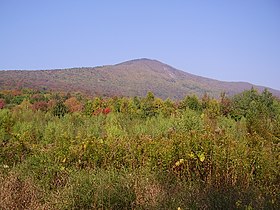Taconic Range
| Taconic Mountains | |
|---|---|

The Taconic peak Mount Greylock, highest point in Massachusetts
|
|
| Highest point | |
| Peak | Equinox Mountain (Bennington County, Vermont) |
| Elevation | 3,850 ft (1,170 m) |
| Geography | |
| Country | United States |
| State |
New York, Connecticut, Massachusetts, Vermont |
| Region | western New England, eastern New York |
| Range coordinates | 42°41.5′N 73°17.1′W / 42.6917°N 73.2850°WCoordinates: 42°41.5′N 73°17.1′W / 42.6917°N 73.2850°W |
| Parent range | Appalachian Mountains |
| Biome |
Northern hardwood forest, Appalachian balds, Taiga, Pitch Pine/Scrub Oak uplands |
| Geology | |
| Orogeny | Taconic Orogeny |
| Age of rock | 440 million years |
| Type of rock | Thrust fault |
The Taconic Mountains or Taconic Range (/təˈkɒnɪk/) are a physiographic section of the larger New England province and part of the Appalachian Mountains, running along the eastern border of New York State and adjacent New England from northwest Connecticut to western Massachusetts, north to central western Vermont. The range includes notable summits such as Mount Equinox and Mount Greylock, the highest point in Massachusetts. Currently local residents, along with the prominent 19th century geologist, T. Nelson Dale, consider the Mount Greylock Massif as a subsidiary of the main Taconic Range to the west.
The Taconic Range is known for its ecological value, conservation land, scenic landscapes, natural environment, and recreational facilities. It contains several hundred miles of trails including sections of the 2,175-mile (3,500 km) Appalachian Trail and over sixty designated areas of land protected by federal, state, county, and municipal, government agencies and non-profit organizations. The range has been targeted for conservation by government agencies in four states, the federal government, and over a dozen non-profit organizations. The Nature Conservancy calls the Berkshire Taconic landscape, which includes part of the Taconic Range, one of its "Last Great Places." Multiple government and non-profit conservation partnerships have been formed with the intention of conserving the Taconic landscape and ecosystem.
"Taconic", a Native American name, was once transliterated as the Taghkanic or Taughannock, meaning "in the trees" and used as the name of a Lenape chieftain. Taghkanic is still used in parts of eastern New York, as in the name of a small town in the region, for both features within and outside the Taconic Mountains region.
...
Wikipedia

